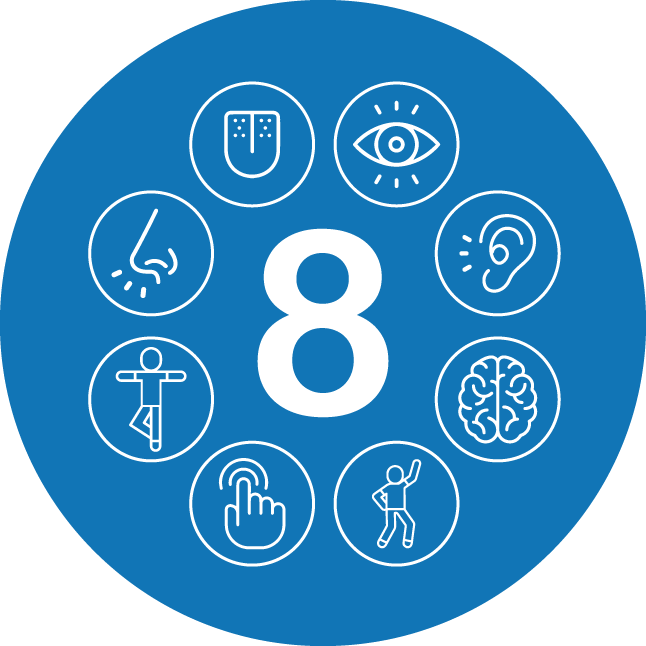Addressing Sensory Processing Issues with the Tomatis®Method

Your Starter Guide to Tomatis® - Completely Free
8 Senses, 8 sources of sensory issues
Sensory Processing Disorder? Sensory Integration Disorder? Hyposensitive? Hypersensitive? Is it a sensory issue? These are often terms that pop up on any Google search. The senses are key to understanding the world around us and how we interact with it and others. They are very much involved in one’s ability to adapt to and manage the demands of any environment. They are also involved in how we can self-regulate and handle daily stresses such as missing your train to planning a birthday party.
What are our senses and what do they do? It is often surprising for people to learn that humans have eight senses rather than five. Each of the eight senses contributes to our sense of safety, to our sense of mastery over our own body, and our ability to function on a day-to-day basis.
Mostly everyone knows the 5 most common and most familiar senses:
- Visual – our sense of sight
- Auditory – our sense of hearing
- Olfactory – our sense of smell
- Gustatory – our sense of taste
- Tactile – our sense of touch & sensations
The 3 senses you may not know as much about:
- Vestibular – the sense of balance, coordination, and eye movements, how fast or slow you are moving, body position, orientation in space
- Proprioception – the sense of awareness of your body’s movement, location, and actions, posture
- Interoception – the sense of how you feel what’s going on in your own body i.e., feeling hot, cold, hungry, sick or even your emotions

Everyone uses all their senses on a daily basis from maintaining your balance on a metro, to reading a book, to eating a meal with friends, and the list goes on and on. Everyone has sensory preferences and habits. Some of us prefer more physical sports, some prefer more spicy foods, and some prefer quieter spaces. It’s great to have things you like and even things you don’t like as much.
But what happens when those sensory preferences are more extreme and impact your ability to function daily?
What is Sensory Processing Disorder (SPD) or Sensory Integration Disorder?
When the ability to process sensory input accurately and efficiently is impaired, it can lead to a condition called Sensory Processing Disorder or SPD for short. SPD is a condition that affects the way the brain processes information from the senses. In simple words, it is a neurological “traffic jam” that prevents certain parts of the brain from receiving sensory information from our senses to respond appropriately. This can impact your ability to work, go to school, and activities of daily living.
If you or your child have been diagnosed with SPD or you know someone who has been diagnosed, you may have heard associated terms like hypersensitivity and hyposensitivity. In both children and adults, sensory processing disorders fall into two main categories:
1. Hypersensitivity (over-responsiveness, extra sensitive) to sensory stimuli or
2. Hyposensitivity (under-responsiveness, not reacting at all) to sensory stimuli.
It is also possible to have a combination of both hypersensitivity to certain sensory stimuli and hyposensitivity to other sensory stimuli, which can often be perplexing to figure out.
What are the signs of sensory processing disorders?
If you or your child experience sensory issues, such as discomfort with bright lights, loud noises, or clothing tags, or struggle with motor skills and interacting with the environment, please know that you are not alone. Sensory processing disorder (SPD) affects 1 in 20 people in the general population.
Signs of Hypersensitivity
- Negative reaction to sudden, loud, or metallic noises
- Difficulty focusing and paying attention
- May perceive or be aware of background sounds that are typically unnoticed by others.
- Fearful of surprise touches, crowds, swings, and playground equipment
- Avoids hugs and cuddling even with familiar adults
- Avoids standing in close proximity to others
- Fearful of climbing, falling or movement
- Preference for specific foods or gagging on certain textures
- Low pain threshold and appears clumsy
- Lack of emotional control
Signs of Hyposensitivity
- Tendency to touch people or textures inappropriately
- Lacks understanding of personal space
- Uncoordinated and clumsy movements
- High pain tolerance
- Plays rough with other kids and pets, not understanding their strength
- Fidgety and unable to sit still
- Enjoys movement-based play like spinning and jumping
- Thrill seeker and sometimes engages in dangerous behaviors
- Enjoys putting things in the mouth
- Gives bear hugs
Could sensory issues be a sign of another condition?
Sensory Processing Disorder (SPD) is a condition that includes a broad range of sensory difficulties. One form of this disorder is Auditory Processing Disorder (APD), which involves difficulties in processing auditory information. SPD often coexists with other diagnoses and is strongly linked to ADHD and Autism Spectrum Disorder, where 92% of individuals have both conditions. It’s important to note that sensory issues can affect both children and adults.
There are several conditions or disorders related to sensory issues, including:
Sensory Processing Disorder and Autism Spectrum Disorder (ASD)
A significant number of individuals with ASD experience sensory processing difficulties. Rates of sensory processing dysfunction may be as high as 90% in individuals with Autism (Baranek et al., 2006 ; Leekam et al., 2007 ; Tomchek and Dunn, 2007 ; Baker et al., 2008 ) and are estimated to be between 5% and 16% in the general population (Ahn et al., 2004 ; Ben-Sasson et al., 2009 ). They may exhibit heightened sensitivity to sensory stimuli such as textures, sounds, and lights, which can lead to sensory overload. On the other hand, some may actively seek intense sensory experiences. This dual presence of ASD and SPD can impact behavior, social interactions, and well-being. Managing sensory sensitivities is often a key component of supporting individuals with ASD.
Attention Deficit Hyperactivity Disorder (ADHD) and Sensory Processing Disorder
Anxiety Disorders and Sensory Processing Difficulties
For individuals with anxiety disorders, sensory processing issues can aggravate their anxiety. Overwhelming sensory environments, such as crowded spaces, loud noises, or unexpected physical contact, can trigger heightened anxiety responses. Addressing sensory sensitivities is essential in managing anxiety disorders when SPD is also present.
Learning Disabilities and Sensory Processing Issues
Children with learning disabilities may also struggle with sensory processing, which can hinder their learning efficiency. Sensory sensitivities, such as an aversion to certain textures or lighting conditions, can interfere with academic tasks. Accommodations in the learning environment and tailored educational strategies are often necessary to support children with this combination of challenges.
Developmental Coordination Disorder (DCD) and Sensory Processing Disorder
DCD, also known as dyspraxia, impacts motor coordination and is often associated with SPD. Both disorders involve challenges in processing sensory information for motor responses. The combination of DCD and SPD can complicate everyday activities such as dressing, writing, or participating in sports, requiring targeted therapeutic interventions.
Even though all children are quirky or particular about what they like and dislike, children with SPD (also known as Sensory Integration Dysfunction) are negatively affected by their sensory preferences, which can impair their normal functioning.
How can The Tomatis® Method help with Sensory Processing Issues?
It is common for Sensory Processing Disorder (SPD) or Sensory Integration disorder to manifest itself in a variety of small, sometimes bizarre ways. The Tomatis® Method is a neurosensory (ear-brain-body) training method that is non-invasive, natural, and can be used in complement with sensory integration therapies. In addition to sensory integration, the Tomatis® Method improves gross motor skills, speech & language, posture, and balance, as well as regulates emotions in people with SPD. Not only does the Tomatis® Method contribute to increasing the brain’s ability to integrate sensory information, but it also creates a nurturing, low-pressure environment that is conducive to patients’ receptivity to auditory training.
What benefits can be expected from the Tomatis® Method?
SPD signs and behaviors vary from person to person, and so will the benefits derived from the Tomatis® Method. The Tomatis® Method will work in ways that will contribute to developing Sensory Processing abilities.
Some benefits* users observe by following the Tomatis® Listening Program, but not limited to, are:
Reduced Sound Sensitivity
Improved tolerance to sound stimuli, leading to reduced discomfort or agitation triggered by noise.
Better Self-Regulation and Self-Awareness
Enhanced ability to regulate emotions and behaviors in response to sensory input, promoting better self-awareness and control.
Increased Attention Span
Improved ability to sustain focus and attention, leading to better engagement in tasks and activities
Improved Listening Skills
Enhanced capacity to process and comprehend auditory information, leading to better understanding and following of instructions.
Enhanced Auditory Processing
Improved brain's ability to interpret and make sense of sounds, aiding in better communication and comprehension
Improved Learning Ability
Enhanced capability to absorb and retain information, leading to better learning outcomes in educational settings
Clarity in Speech and Language Skills
Enhanced articulation and language development, leading to clearer speech and improved communication abilities
Enhanced Independence with Activities of Daily Living (ADLs)
Improved ability to perform daily tasks independently and recreational pursuits effectively (e.g., Brushing Teeth, Showering, etc.)
Improved Motor Skills
Improved fine and gross motor skills result in enhanced handwriting and contribute to activities like walking and running.
Increased Awareness of Body and Movement
Better understanding and recognition of body movements, contributing to improved spatial awareness.
Improved Quality of Life in Various Settings
Enhanced well-being and comfort in school, home, and community environments
Reduced Anxiety and Fewer Tantrums / Meltdowns
Decreased stress and emotional outbursts, facilitating a calmer and more regulated emotional state
*It’s important to note that the Tomatis® Method is not a substitute for traditional therapy for SPD. Outcomes may differ among individuals, so consulting with a professional who can assess and recommend the most suitable approach for your specific needs is essential.
Why can the Tomatis® Method help SPD?
The Tomatis® Method offers valuable support for individuals with SPD by utilizing auditory stimulation with specific sound frequencies to enhance traditional therapy outcomes. Dr. Tomatis understood the brain’s ability to adapt and learn through neuroplasticity, which forms the foundation of this method. By using sound and music, the Tomatis® Method stimulates the brain, leading to improved auditory processing, cognitive and motor skills, and emotional regulation. The program promotes neuroplastic changes, creating neural pathways to handle sensory stimuli efficiently. With each session, sensitivity to sounds diminishes, attention improves, emotions stabilize, and motor skills are enhanced.
As the ear is the king of sensory processing, the method’s positive stimulation of the auditory system significantly benefits motor development, concentration, attention, speech, language, social skills, and emotional regulation. It helps improve muscle tone, posture, balance, and coordination, leading to clearer perception and communication of sounds.
What sensory processing disorder therapies can the Tomatis® Method be added to?
While sensory issues or sensory processing disorders have no standard remedy, there are some therapy options that may help.
Occupational therapy
Occupational therapists (OTs) help children with sensory issues by guiding them through new activities and working with teachers to support their sensory needs at school. They utilize various sensory tools, including the Tomatis® Method, which uses voice and music to accelerate results and reduce program duration. This method can be incorporated between sessions or alongside other therapy programs.
Physical therapy
Physical therapists can assess and work on improving a child’s motor coordination and balance, which are often affected in individuals with SPD, which are a function of the vestibular system. This can include exercises and activities that enhance gross motor skills, like running, jumping, and balancing. Therapists use the Tomatis® Method as it improves the vestibular. Often used as a sensory tool in their protocol during physical therapy or to their client’s at-home sensory schedule to decelerate sensory and sound sensitivity, making it a good complement for PTs.
Sensory integration therapy
Sensory integration therapy includes both occupational and physical therapy. A more typical response may be learned by using this approach. It is designed to help the child learn how to respond appropriately to his or her senses. Using SI and Tomatis® in tandem results in long-lasting results and shorter program durations.
The Tomatis Method is an auditory stimulation program that can help individuals with sensory processing issues, including Auditory Processing Disorder (APD) and Sensory Processing Disorder (SPD). Individuals can reach their full potential by training the brain to process information more quickly and accurately. It is important to keep in mind that the Tomatis® Method is not a cure-all, and it is important to work with a professional to determine the best course of action for your individual needs.
Frequently Asked Questions
-
Can an auditory stimulation program be used for APD or SPD?
Auditory intervention or listening therapies stimulate the brain and improve listening mechanisms, enhancing the effects of traditional therapies when used in conjunction. These programs improve how the brain processes auditory information, enhancing listening skills, sound discrimination, and auditory perception. By addressing these challenges, they support better communication, learning, and daily functioning for individuals with APD or SPD. -
My child with SPD gets stressed when it is time to head to a clinic. Can we implement the Tomatis® Method at home?
We pride ourselves to present to you the Tomatis® at-home program where you or your child can receive the benefits of the method in the comfort of your home. -
My child is hypersensitive to sound. Can the Tomatis® listening program be used by him/her?
The Tomatis® Method is customized to fit the client's needs. Depending on individual requirements, the practitioner may recommend either headphones or a preparation program using the bone conduction kit, which delivers listening stimulation through a belt instead of headphones. This preliminary phase prepares the child for the main Tomatis® program. Typically, the Tomatis® Method consists of three or more 14-day sessions, with approximately 4-6 weeks of breaks between each session. This structure allows clients time to integrate and adjust to the changes (acclimatize) from the program. Practitioners have the flexibility to tailor the program to each client's specific needs, ensuring a personalized and effective approach. -
Why should the Tomatis® Method be integrated into my child’s treatment plans/sensory integration therapy?
A unique feature of the Tomatis® method is that it addresses the root of the problem, which enables the maturity of sensory systems to become optimized sooner. Additionally, you have the option to use it in conjunction with traditional therapy and enhance the overall success of the treatment. -
How are sensory issues diagnosed?
Since sensory processing disorder is not an officially recognized neurological condition, there are no formal diagnostic criteria. Some professionals use a sensory integration questionnaire to better understand a child’s sensory processing along with the sensory integration praxis test. You should consult a doctor if you see any of these signs:- Everyday life is disrupted by the behavior
- Symptoms are difficult to manage
- Reactions have become impossible to control
- Learning is impacted by sensory issues
-
Is there a way to determine if I have a sensory issue or something else?
It is largely believed SPD is a component of another condition or disorder. SPD, however, is not an officially recognized mental health condition. Many people on the autism spectrum experience sensory issues. However, not everyone with sensory issues is on the autism spectrum. Others may have ADHD, OCD, or developmental delays, or they may not even have a diagnosis. We recommend that you seek a professional specifically trained in sensory integration to help determine if it is in fact SPD or another diagnosis.
Start your Journey with Tomatis®
To maximize your chances of success with the Tomatis® Method, please follow these steps :
Get your personalized Tomatis® Welcome Booklet
Find the best Practitioner with our interactive Map
Start your Listening Program and transform your Life




